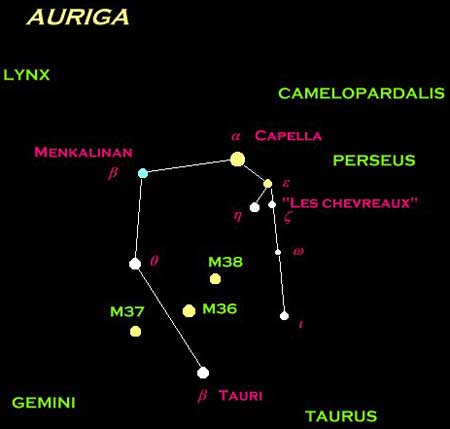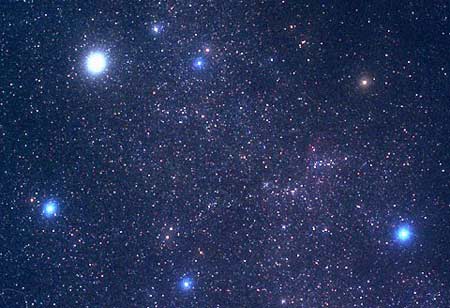In the winter sky, from the constellation Gemini, looking towards the Milky Way to the west, five bright stars form a pentagon. The southernmost star in this pentagon is Taurus Beta. The other four stars, along with nearby stars, create the constellation Auriga. The brightest star in this constellation is Auriga Alpha, also known as Menkalinan.

Diagram of the Auriga Constellation (Photo: membres.lycos)
Half of the constellation Auriga lies within the Milky Way, with Gemini to the southeast, Perseus to the northwest, Taurus to the south, and Lynx to the north. We can use the Auriga constellation to locate the North Star. By extending the line from stars Ø and ß northward about three times, we will encounter the North Star.
Greek mythology tells that Zeus’s father, Kronos, was very ruthless, devouring all of his children because he believed in a prophecy that one of them would overthrow him and rule the gods. When Zeus was born, his mother tricked Kronos by giving him a stone to swallow instead, secretly raising Zeus on the island of Crete with goat’s milk. Later, Zeus overthrew Kronos and became the ruler of the gods. Remembering the nurturing of his foster mother, the goat, he took the goat and her two kids to the sky, where they became the goat sitting on the shoulders of the charioteer in the constellation Auriga. Zeus and his wife Hera had a son named Hephaestus, who had a disability in his legs. He had a child who also had difficulty walking, so he invented a four-horse chariot to make it easier for himself to travel. As a reward for this invention, Zeus elevated him to the sky as the constellation Auriga. Zeus entrusted the care of the mother goat and her two kids to him.

(Photo: malyszp.tripod)


















































